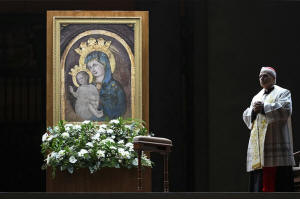Pope Francis no longer requires mechanical ventilation after respiratory
crisis
[March 04, 2025]
By NICOLE WINFIELD
ROME (AP) — Pope Francis had stabilized enough Tuesday after two
respiratory crises to be taken off noninvasive mechanical ventilation
and receive just high flows of supplemental oxygen, as he continued his
more than two-week long fight against double pneumonia, the Vatican
said.
Francis, 88, woke up and was resuming respiratory physiotherapy after
sleeping through the night, the Vatican said.
The Vatican said as of Tuesday morning, Francis no longer needed to wear
the mechanical ventilation mask that covers his nose and mouth to pump
oxygen into his lungs and was just receiving supplemental oxygen through
a nasal tube.
He had to resume using the mask on Monday after suffering two
respiratory crises that required doctors to extract “copious” amounts of
mucus from his lungs. Doctors performed two bronchoscopies, in which a
camera-tipped tube was sent into his airways with a sucker at the tip to
suction out fluid.
The 88-year-old pope, who has chronic lung disease and had part of one
lung removed as a young man, remained alert, oriented and cooperated
with medical personnel, the Vatican said. The prognosis remained
guarded, meaning he was not out of danger. Doctors didn’t say if he
remained in stable condition, though they referred to the crises in the
past tense.
The fact that Francis no longer needed the ventilation mask by Tuesday
morning was a sign that he had stabilized some after the crises, but
still within what doctors have said was a complex respiratory picture.
The crises were a new setback in what has become a more than two-week
battle by the frail pope to overcome a complex respiratory infection.

The Vatican said the mucus that had accumulated in Francis' lungs was
his body’s reaction to the original pneumonia infection and not a new
infection, given laboratory tests don’t indicate any new bacteria.
Dr. John Coleman, a pulmonary critical care doctor at Northwestern
Medicine in Chicago, said the episodes were more concerning than the
last one on Friday, in which Francis had a coughing fit, inhaled some
vomit that needed to be extracted, was put on the noninvasive mechanical
ventilation for a day and then didn’t need it anymore.
The use of bronchoscopies reflects a worrying level of mucus and phlegm
in the lungs, Coleman said. “The fact that they had to go in there and
remove it manually is concerning, because it means that he is not
clearing the secretions on his own,” he said.
[to top of second column]
|

Cardinal Robert Francis Prevost, Prefect of the Dicastery for
Bishops, leads the recitation of the Holy Rosary for Pope Francis'
health in St Peter's Square at the Vatican, Monday, March 3, 2025.
(AP Photo/Kirsty Wigglesworth)

“He’s taking little steps forward and then steps back,” said
Coleman, who is not involved in Francis’ care.
Francis, who is not physically active, uses a wheelchair and is
overweight, had been undergoing respiratory physiotherapy to try to
improve his lung function. But the accumulation of the secretions in
his lungs was a sign that he doesn’t have the muscle tone to cough
vigorously enough to expel the fluid.
Doctors often use noninvasive ventilation to stave off an
intubation, or the use of invasive mechanical ventilation. Francis
has not been intubated during this hospitalization. It’s not clear
if he has provided any advance directives about the limits of his
care if he declines or loses consciousness.
Catholic teaching holds that life must be defended from conception
until natural death. It insists that chronically ill patients,
including those in vegetative states, must receive “ordinary” care
such as hydration and nutrition, but “extraordinary” or
disproportionate care can be suspended if it is no longer beneficial
or is only prolonging a precarious and painful life.
Francis articulated that in a 2017 speech to a meeting of the
Vatican’s bioethics think tank, the Pontifical Academy for Life. He
said there was “no obligation to have recourse in all circumstances
to every possible remedy.” He added: “It thus makes possible a
decision that is morally qualified as withdrawal of ‘overzealous
treatment.’”
Archbishop Vincenzo Paglia, who heads the academy which helps
articulate the Catholic Church’s position on end-of-life care, said
Francis is like any other Catholic and would follow church teaching
if it came to that.
“Today the pope is giving us an extraordinary teaching on
fragility,” he told reporters Monday. “Today the pope, not through
words but with his body, is reminding all of us, we elderly people
to begin with, that we are all fragile and therefore we need to take
care of each other.”
Francis’ hospitalization, which hits 18 nights Tuesday, is by no
means reaching the papal record that was set during St. John Paul
II’s numerous lengthy hospitalizations over a quarter century. The
longest single hospitalization occurred in 1981, when John Paul
spent 55 days in Gemelli for a minor operation and then to be
treated for a serious infection that followed.
All contents © copyright 2025 Associated Press. All rights reserved |